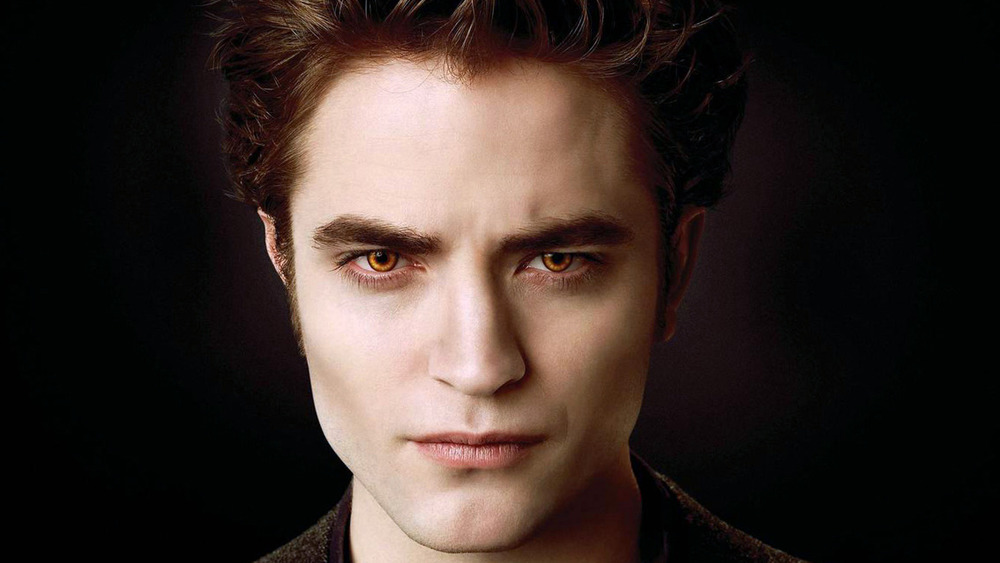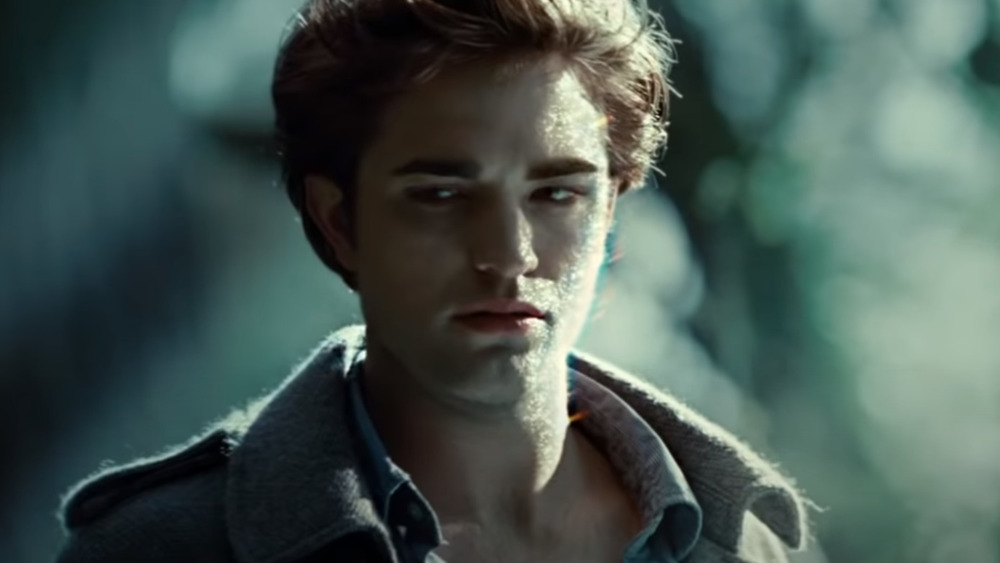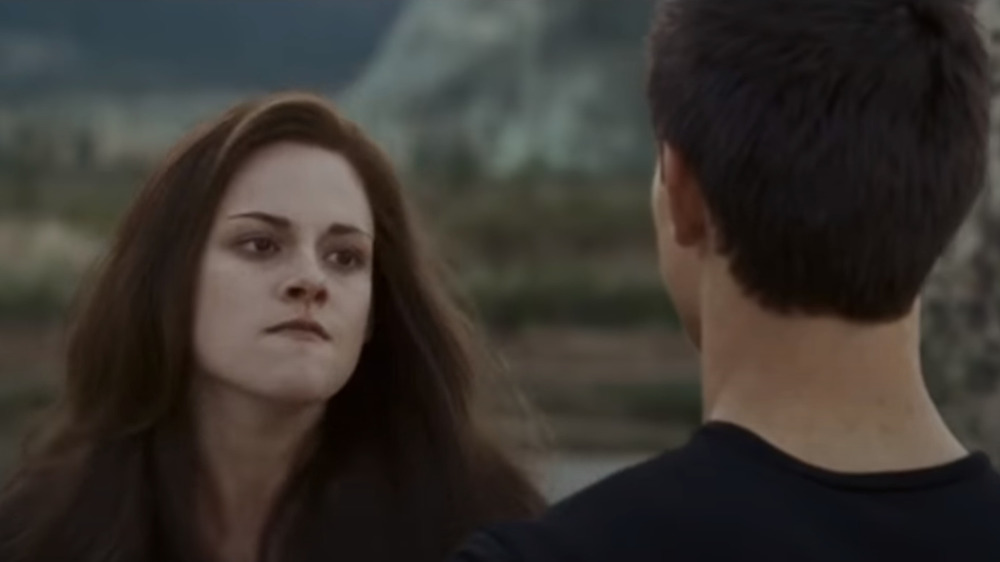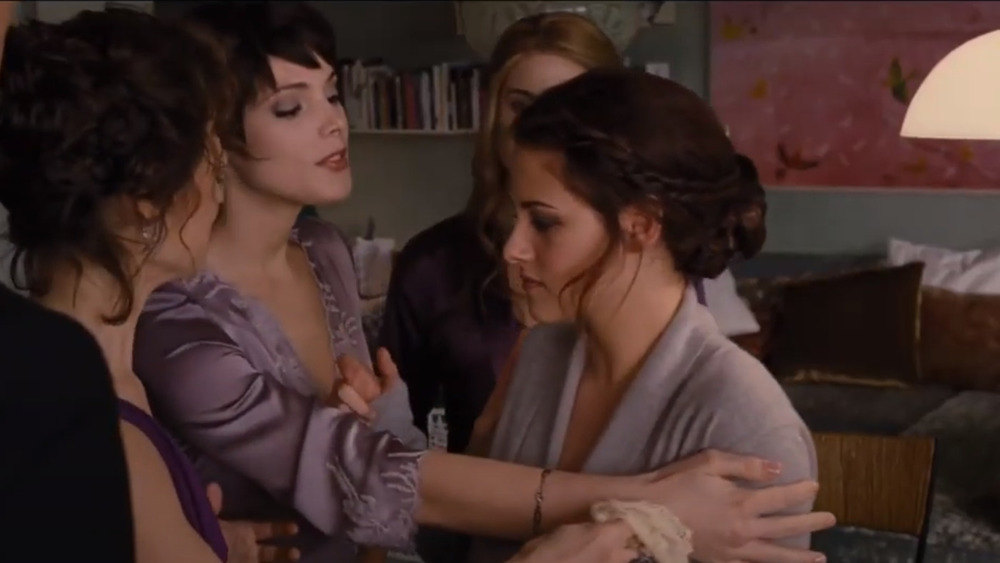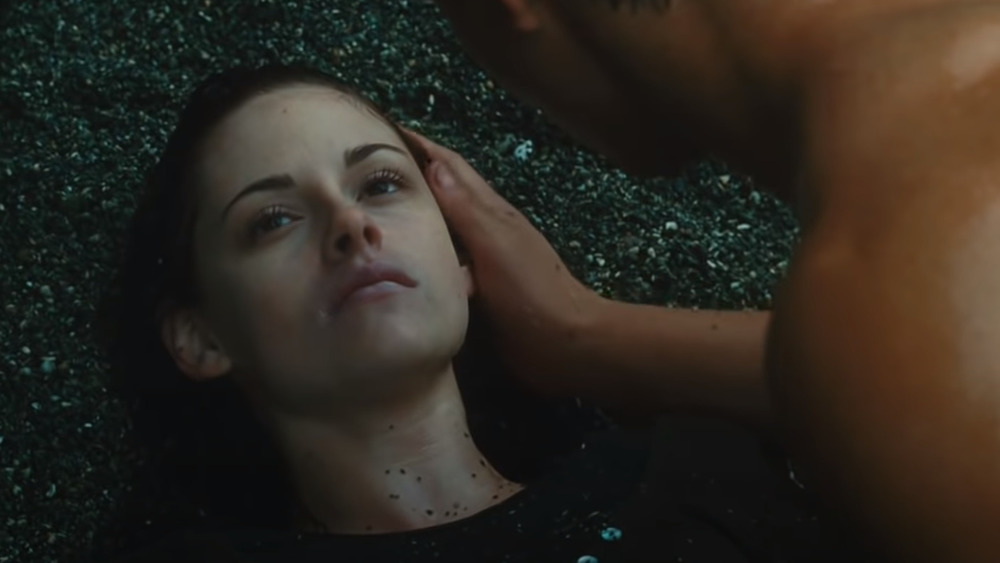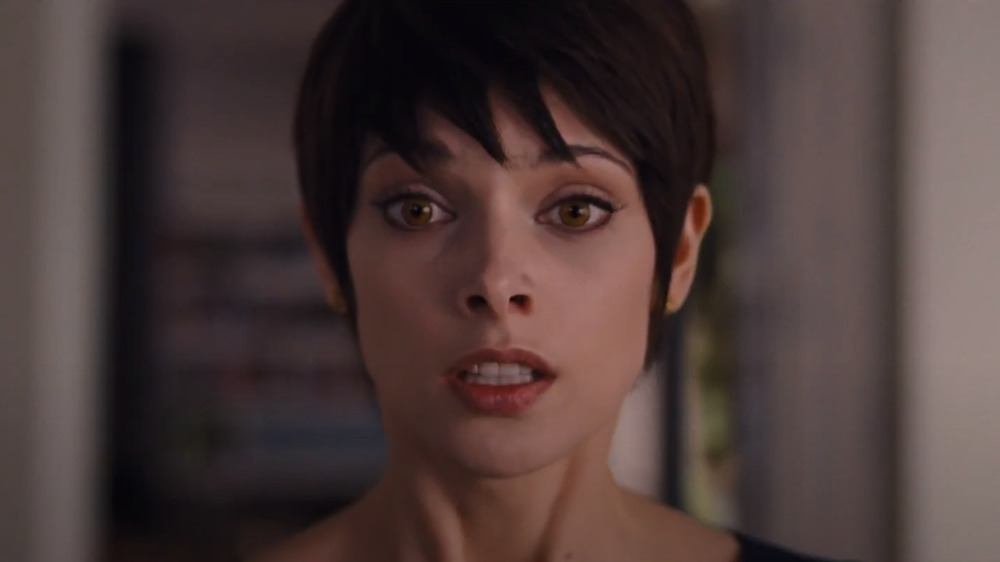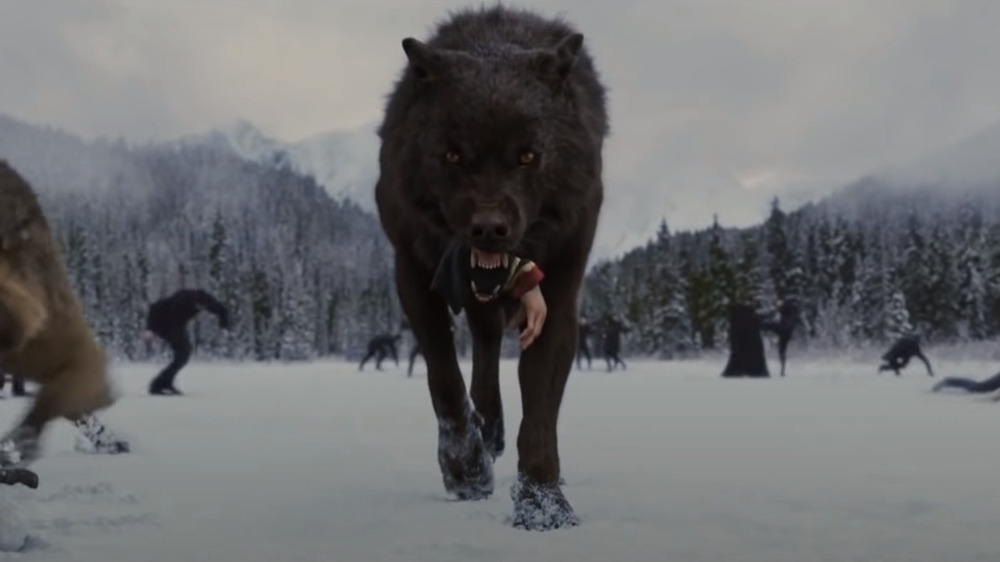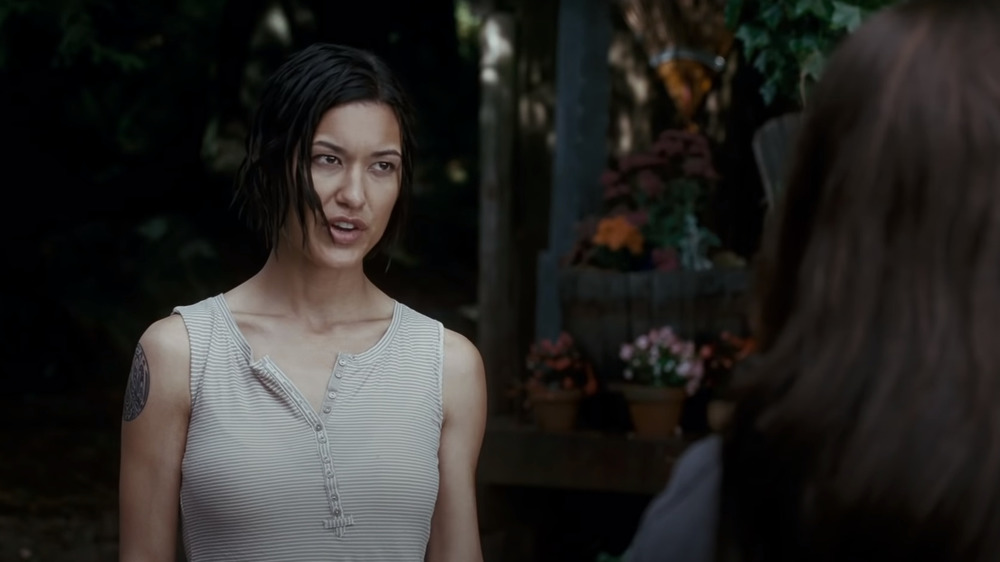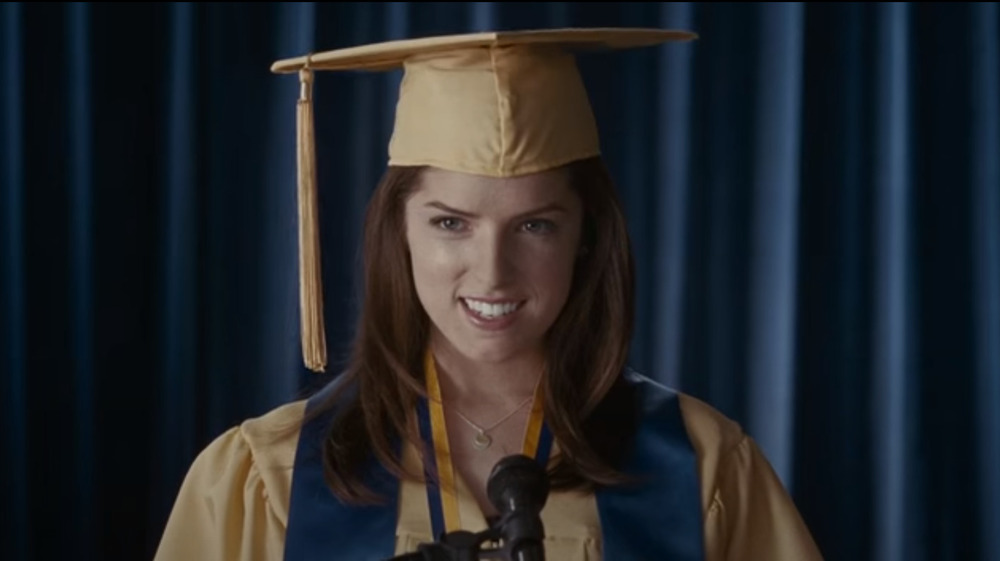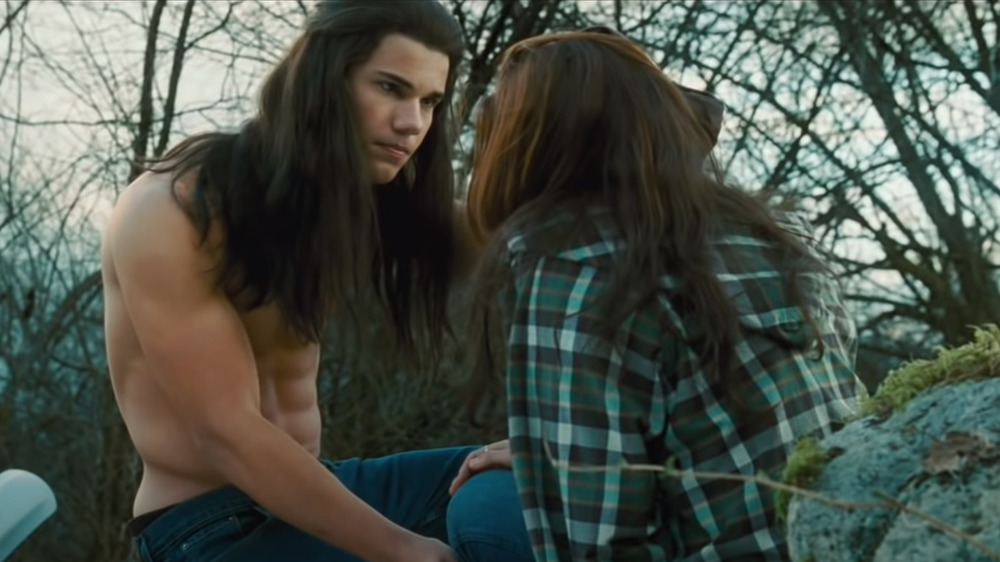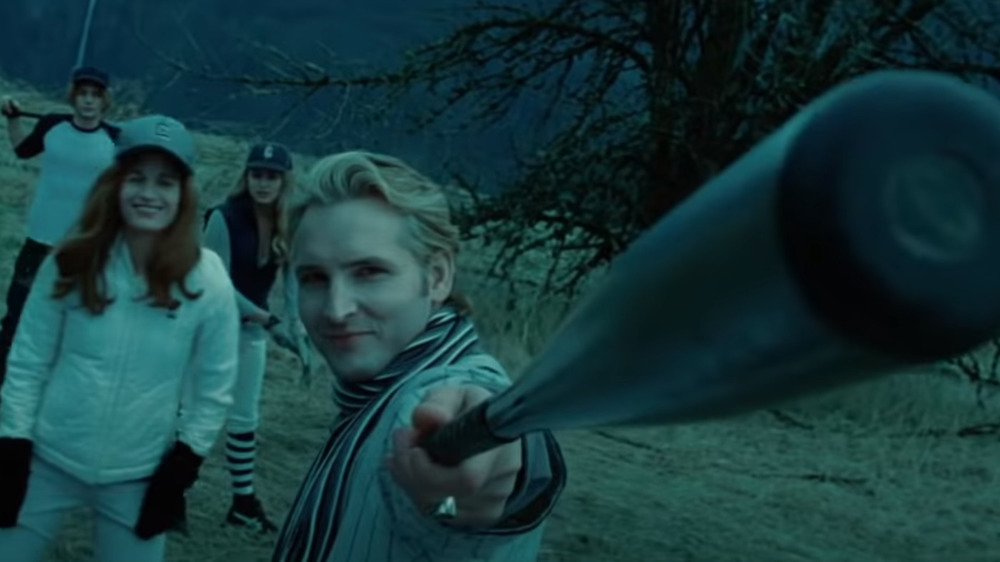Things That Happen In Every Twilight Movie
In 2005, the world of pop culture changed forever when Stephenie Meyer published Twilight, a supernatural teen romance novel about a girl who falls in love with a vampire. The book became a bestseller almost immediately, and subsequent installments in what would come to be known as "the Twilight Saga" followed suit, riding a wave of fan support that peaked in 2008. That storied year saw the release of both the final book in the series, Breaking Dawn, and the first blockbuster Twilight movie. Like anything beloved by women and girls, both the books and the movies gained a legion of belligerent detractors, but the hostility between the series' fans and its critics only made the story of Bella Swan, Edward Cullen, and Jacob Black even more widely known.
The five extremely successful film adaptations of Twilight are, if nothing else, a spectacle. Thanks to the franchise's globe-spanning popularity, they have a certain brand to maintain. There are things everyone automatically expects from a Twilight film: Vampires and werewolves, love triangles, bad CGI, etc. But only a handful of things can be relied on to take place in every single Twilight movie. We're here to take a look at what those ever-present elements are.
For those who have yet to choose between Team Edward, Team Jacob, or Team It's-Okay-To-Be-Single-Bella, massive spoilers follow for the entire Twilight Saga.
A lack of sparkly vampires
There's one thing that absolutely everybody knows about Twilight: The vampires sparkle. Specifically, in Stephenie Meyer's universe, vampires avoid sunlight not because it will burn or destroy them, but because it will reveal that they are glittering creatures who seem to be made less of flesh than of diamond. This has been a point of contention among the series' detractors since the publication of the first novel in 2005, though it's also one of Meyer's most original ideas, and the most singularly distinctive element of Twilight's take on vampires.
So you'd think that the film adaptations would feature a decent number of shots in which the vampires do, in fact, sparkle, right? Wrong. Edward reveals his true sparkly nature to Bella in the first film by stepping into a shaft of sunlight and lighting up like a Christmas tree. After that, though, you'd be hard pressed to list the scenes in which this unique element of Meyer's lore shows up –- even when the characters are traveling by day in Arizona or Italy, or standing outdoors in a shot that's certainly lit as though it takes place in direct sunlight. Most glaring (well, literally the least glaring) is the second scene of Eclipse, in which Bella and Edward are relaxing in a sunny meadow. With nobody around to see him, Edward's face sparkles with every move ... until, suddenly, it stops, almost as though the filmmakers forgot about it mid-scene.
Unhealthy relationships galore
Lack of sparkles aside, the Twilight films are actually very good at remaining faithful to their source material. Unfortunately, that means the films pretty much directly import the romantic relationships between the major characters, which are toxic at best and abusive at worst. Edward being inappropriately possessive of Bella, as well as downright cruel to her, is a feature of the first movie as it is of the first book. Even Meyer herself seems to realize this misstep: Her 2020 Twilight companion novel, Midnight Sun, spends an inordinate amount of time re-contextualizing Edward's behavior in the first book in an attempt to make it more palatable. In New Moon, he leaves Bella dramatically before getting her back via an even more dramatic suicide attempt, only to become still more possessive in Eclipse.
Fortunately, by the time Breaking Dawn comes around, Edward has grown somewhat and stops behaving like a weird stalker. But that gives Jacob Black enough time to step up and fill the creeper role, as he proceeds to obsess over Bella, emotionally manipulate her, forcibly kiss her, and try to sabotage her relationship with Edward in Eclipse and Breaking Dawn –- Part 1, despite her getting both married and pregnant in the latter film. In Breaking Dawn –- Part 2, Jacob finally gets over Bella ... but only because he magically falls in love with her newborn baby. If that's not an unhealthy relationship, we don't know what is.
Alice plays dress up
While Bella's romantic entanglements are often unhealthy, she does have a positive relationship with Edward's sister, Alice. Well ... mostly positive, anyway. In the books, Alice also engages in abusive behavior toward Bella, as when she uses her ability to see the future to help Edward control Bella's activities in Eclipse. But that version of Alice doesn't really make it into the movies — for the most part, she's portrayed simply as a good friend. But one thing that will never change, no matter the medium, is the power Alice wields over Bella's wardrobe, particularly when there's some sort of event to be attended.
Twilight ends with Bella and Edward attending prom, though Bella doesn't initially know that's where they're going. She does, however, wear the first of many dresses given to her by Alice. The same thing happens in New Moon, which shows Alice giving Bella a dress as a birthday present, specifically to be worn to a celebration at the Cullens' home. After Bella and Edward decide to get married at the end of Eclipse, Bella tells Edward she's giving Alice charge of the preparations, and in Breaking Dawn -– Part 1, we do indeed see Alice dressing Bella for her wedding day. She's also packed some –ahem — choice items for the honeymoon. Finally, in Breaking Dawn –- Part 2, Alice leads the couple to a cottage not far from the Cullens' house, which comes, mysteriously, with a fully-stocked wardrobe.
Bella risks her own life
The Twilight series has never been shy about Bella's characterization as an awkward and fashion-indifferent young woman. But Bella has an even more defining trait that comes up in every film. The very first lines of the first Twilight movie are, "I'd never given much thought to how I would die. But dying in the place of someone I love seems like a good way to go." This willingness to sacrifice herself, usually on behalf of a loved one, is a running theme in the movies.
That line in particular refers to Bella making the choice, in the first film, to ditch her vampire protectors and meet up with the murderous vampire James in order to save her mother. In New Moon, her motives for risking her own life are less noble, as she's turned to dangerous thrill-seeking after being dumped by Edward. But she's back to putting others first by Eclipse, which sees her use her own blood to draw the attention of vampires Victoria and Riley so that Edward can defeat them. The Breaking Dawn films continue the theme, first when she chooses to carry her child to term despite the havoc pregnancy wreaks on her body, and then when she prepares, alongside the rest of her family, to face down the Volturi. There's a reason, after all, that once Bella becomes a vampire, she gains the ability to shield others from supernatural powers.
Alice's visions drive the plot
Meyer breaks from traditional vampire mythology in a major way when it comes to her portrayal of supernatural powers. While traditional vampires have a generally accepted set of extraordinary abilities, several of Meyer's vampires have their own unique powers, most of which are beyond even the most fevered dreams of Dracula. Telepathy, emotion control, illusions, instant infliction of pain, supernatural luck, and manipulation of the elements are all vampiric powers in Twilight. And no power is more useful than the one Alice Cullen possesses: The ability to see into the future. Alice's visions drive the plot of the Twilight movies more directly than any romance.
Every Twilight narrative relies heavily on Alice's powers. She sees Bella's old ballet studio in a vision in the first film, where Bella ultimately confronts James. In New Moon, she mistakes her vision of Bella's attempt at cliff-diving as a suicide, which leads to Edward and Bella getting back together. Her prediction to the Volturi that Bella will someday be a vampire is the only reason they get out of Italy alive. She spends pretty much all of Eclipse providing intelligence on Victoria's movements alongside her army of newborn vampires. Finally, the over-arching plot of the Breaking Dawn duology is entirely resolved thanks to Alice's visions, particularly the lengthy sequence of slaughter she confronts the Volturi leader, Aro, with, as a demonstration of why attacking the Cullens would end in his own destruction.
Climactic fight scenes that aren't in the books
Remember that epic fight scene at the end of Breaking Dawn -– Part 2? It's not a scene that occurs in the book. Or at least, it doesn't go down on the page. Breaking Dawn ends in a notoriously placid fashion: The Cullens and their allies meet the Volturi on the field of battle, only for Alice to show Aro a vision of the future in which the Cullens win the upcoming fight. This leads to everyone deciding not to fight after all. The movie opts to actually show Alice's vision to the viewer, though many believe this choice makes the eventual reveal even more infuriating.
This is a trend in the Twilight films, which love nothing more that putting fight scenes on screen that Meyer wasn't interested in describing. Edward's battle with James in the ballet studio in the first movie? In the book, the other Cullens kill James offscreen. Edward fighting the Volturi warrior Felix at the end of New Moon? Never happens on the page. Eclipse's climactic combat between the Cullens and Victoria's vampire army? Book readers hear about it after the fact. And the long-awaited clash between the Cullen vampires and the werewolves of Jacob's pack that closes out Breaking Dawn –- Part 1? Totally made up for the movies. Probably, some bright studio executive didn't want to go broke putting out films that had vampires, werewolves, and superpowers, but no action scenes.
Actual Indigenous actors playing Indigenous people
One of the coolest things about the Twilight movies upping their action content is the increased screen time for the actors playing Jacob's pack of werewolves (though admittedly, they spend most of their action scenes as wolves rendered by shaky CGI). Not only is Twilight one of the few popular sci-fi-fantasy franchises to feature Indigenous people as major characters, it actually cast Indigenous actors, who traditionally don't get a ton of work, in those roles. Gil Birmingham appears as Jacob's father, Billy, in the first four films, while Chaske Spencer, Kiowa Gordon, Tyson Houseman, Alex Meraz, and Bronson Pelletier come in as the first group of werewolves in New Moon, with Eclipse adding Julia Jones and Booboo Stewart as the Clearwater siblings. Eclipse also includes a cameo from Byron Chief-Moon, an Aboriginal Canadian actor and dancer. In fact, the only werewolf played by a non-Indigenous actor is Jacob, played by Taylor Lautner -– though Lautner claims he has some Indigenous ancestry somewhere in his family tree.
Make no mistake: There are numerous legitimate criticisms to be made of Twilight on the grounds of race, from Meyer's appropriation of the real-life Quileute tribe's culture to her refusal to allow original Twilight director Catherine Hardwicke to cast actors of color as the Cullens. But the films do deserve credit for not only featuring Indigenous characters, but for following through and paying Indigenous people to play them.
A star (or future star) in every movie
Kristen Stewart and Robert Pattinson have each gone on to have strange, winding, and celebrated careers: The former has been transformed into an LGBTQ+ icon, while the latter has been cast as Batman, one of the biggest roles in all of film. Conversely, the rest of the primary cast have largely failed to become household names. However, each Twilight film contains at least one secondary cast member whose name we definitely know today.
2008's Twilight was only the fourth credit for Anna Kendrick, who played Jessica Stanley in all but the final film in the series. Kendrick would go on to land starring roles in movies like Up in the Air, Pitch Perfect, Into the Woods, and Trolls. Meanwhile, the arrival of the Volturi in New Moon brought the castings of Michael Sheen as Aro and Dakota Fanning as Jane, two celebrated performers whose lengthy careers stretched before and after the Twilight franchise. When the villainous Victoria was recast in Eclipse, the part went to Bryce Dallas Howard of Jurassic World fame. The Breaking Dawn films brought in Mackenzie Foy as Renesmee, shortly before her award-winning performance in Interstellar and her starring role in The Nutcracker and the Four Realms, and Rami Malek as Benjamin, who would go on to win an Emmy Award for playing Elliot Alderson in Mr. Robot and an Academy Award for playing Freddie Mercury in Bohemian Rhapsody.
Wig problems
Werewolf or vampire, regular cast member or guest star, impressive up-and-comer or grizzled Hollywood veteran –- no matter what role you played in the Twilight franchise, at some point, you almost certainly had to deal with the wig problem. The wigs used by the actors in these movies are both famously uncomfortable and famously noticeable — making fun of them is a favorite pastime of the fan base — and there is no Twilight film that escapes their itchy, poorly blended tyranny.
Some instances of wig-related violence are higher profile than others. Watch the films in order and you'll see Jasper and Alice's hair undergo several sweeping changes: Jackson Rathbone wore wigs in both New Moon and Eclipse with radically diverse results, and Ashley Greene wore a different wig in every film until she got to keep the last one for both parts of Breaking Dawn. Robert Pattinson, in contrast, won the battle against wig-wearing until the final reshoots of Breaking Dawn –- Part 2, when he was forced to don something he called "Frankenstein's monster." Kristen Stewart had capitulated a couple movies earlier, necessarily donning a wig for Eclipse after cutting her hair short to play Joan Jett in The Runaways. Most notoriously, Taylor Lautner's artificially long hair in Twilight and New Moon was so awful, both for him and for viewers, that the crew reportedly gave a standing ovation when Lautner was finally okayed for short hair.
The music slaps
Here's the thing about the Twilight movies: They're not great. While Catherine Hardwicke's original film is at least trying to do something interesting with colors and camerawork, it's sunk by a sub-par script, shaky performances, and a devotion to flawed source material. The ensuing movies are less ambitious, yet still manage about the same level of quality. Are they film classics? No. But if there's one thing that's consistently good about the Twilight films, it's their soundtracks, which introduced indie rock to a brand new generation.
The greatest artifact in this stellar history is the soundtrack to the 2008 movie, which went double platinum and featured songs by Paramore, Iron & Wine, and, most famously, Muse: Their 2006 hit "Supermassive Black Hole" accompanies Twilight's legendary baseball scene, which is one of the absolute best moments of the series. Muse went on to contribute to New Moon and Eclipse, leading to a strong association between that band and the franchise. The New Moon soundtrack also went platinum, and features an even broader spread of artists including Death Cab for Cutie, The Killers, Thom Yorke, Bob Iver, and St. Vincent (who came back for Breaking Dawn -– Part 2) while the Eclipse soundtrack, which went gold, includes Florence + The Machine, The Black Keys, and Vampire Weekend. Hate on Twilight if you want, but do yourself a favor and listen to the soundtracks while you're doing it.
